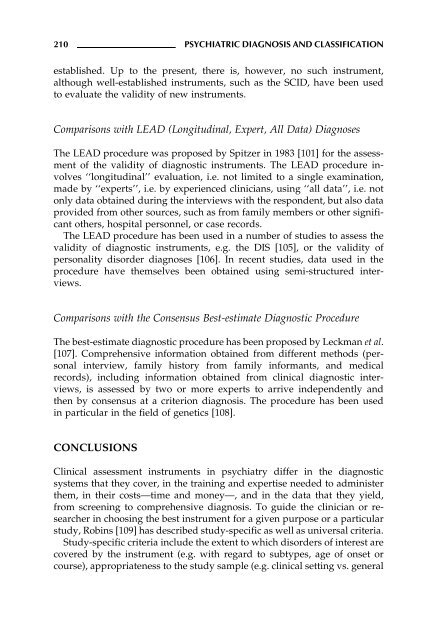Psychiatric Diagnosis and Classification - ResearchGate
Psychiatric Diagnosis and Classification - ResearchGate
Psychiatric Diagnosis and Classification - ResearchGate
Create successful ePaper yourself
Turn your PDF publications into a flip-book with our unique Google optimized e-Paper software.
210 PSYCHIATRIC DIAGNOSIS AND CLASSIFICATION<br />
established. Up to the present, there is, however, no such instrument,<br />
although well-established instruments, such as the SCID, have been used<br />
to evaluate the validity of new instruments.<br />
Comparisons with LEAD Longitudinal, Expert, All Data) Diagnoses<br />
The LEAD procedure was proposed by Spitzer in 1983 [101] for the assessment<br />
of the validity of diagnostic instruments. The LEAD procedure involves<br />
``longitudinal'' evaluation, i.e. not limited to a single examination,<br />
made by ``experts'', i.e. by experienced clinicians, using ``all data'', i.e. not<br />
only data obtained during the interviews with the respondent, but also data<br />
provided from other sources, such as from family members or other significant<br />
others, hospital personnel, or case records.<br />
The LEAD procedure has been used in a number of studies to assess the<br />
validity of diagnostic instruments, e.g. the DIS [105], or the validity of<br />
personality disorder diagnoses [106]. In recent studies, data used in the<br />
procedure have themselves been obtained using semi-structured interviews.<br />
Comparisons with the Consensus Best-estimate Diagnostic Procedure<br />
The best-estimate diagnostic procedure has been proposed by Leckman et al.<br />
[107]. Comprehensive information obtained from different methods personal<br />
interview, family history from family informants, <strong>and</strong> medical<br />
records), including information obtained from clinical diagnostic interviews,<br />
is assessed by two or more experts to arrive independently <strong>and</strong><br />
then by consensus at a criterion diagnosis. The procedure has been used<br />
in particular in the field of genetics [108].<br />
CONCLUSIONS<br />
Clinical assessment instruments in psychiatry differ in the diagnostic<br />
systems that they cover, in the training <strong>and</strong> expertise needed to administer<br />
them, in their costsÐtime <strong>and</strong> moneyÐ, <strong>and</strong> in the data that they yield,<br />
from screening to comprehensive diagnosis. To guide the clinician or researcher<br />
in choosing the best instrument for a given purpose or a particular<br />
study, Robins [109] has described study-specific as well as universal criteria.<br />
Study-specific criteria include the extent to which disorders of interest are<br />
covered by the instrument e.g. with regard to subtypes, age of onset or<br />
course), appropriateness to the study sample e.g. clinical setting vs. general

















